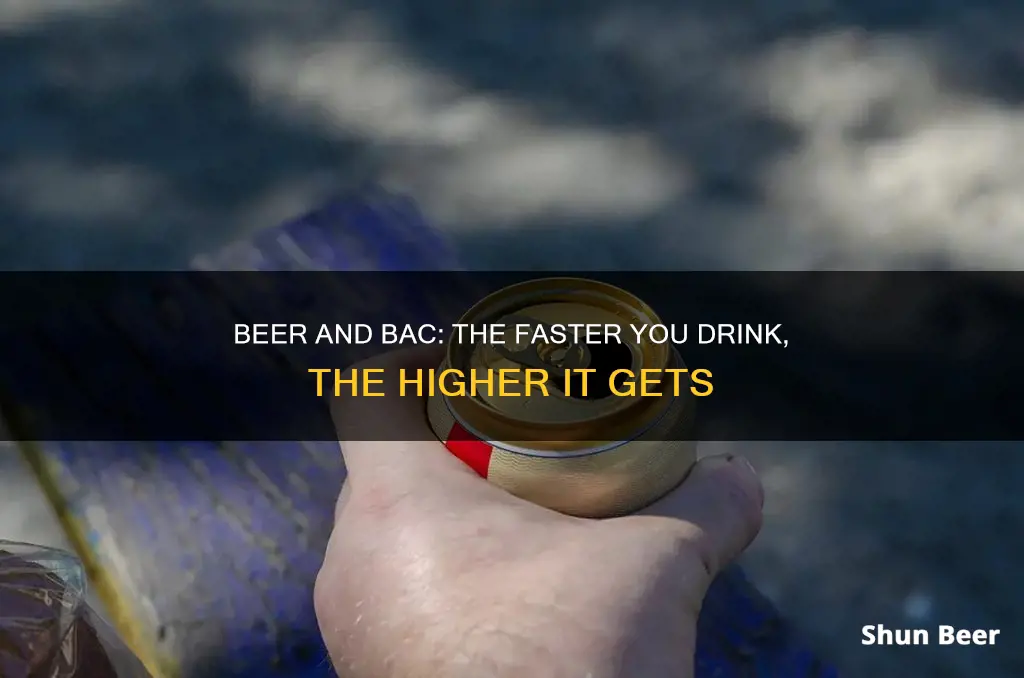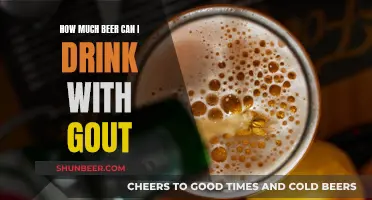
Drinking beer at a faster rate affects your blood alcohol concentration (BAC) by causing it to increase more rapidly. The speed of consumption is a crucial factor in determining your BAC level. When you drink faster than your liver can metabolize the alcohol, your BAC rises, leading to feelings of drunkenness or intoxication. On average, the liver can process about one alcoholic drink per hour, but this can vary depending on various factors such as the amount of alcohol, how quickly you're drinking, your age, weight, and how much food you've eaten. Eating before or while drinking can slow down the absorption of alcohol, resulting in a lower BAC. However, drinking on an empty stomach causes your BAC to rise more quickly. Therefore, drinking beer at a faster rate will lead to a higher BAC and increased intoxication effects.
| Characteristics | Values |
|---|---|
| How drinking beer fast affects BAC | Drinking beer fast can cause a rapid increase in BAC as the alcohol is quickly absorbed into the bloodstream. The faster drinking speed also means that the body cannot metabolise the alcohol as quickly as it is being ingested. |
| Factors affecting BAC | The amount of alcohol consumed, how quickly it is consumed, how much food was eaten before drinking, body weight, metabolism, gender, and individual tolerance. |
| Food's impact on BAC | Food can slow down the absorption of alcohol, leading to a lower BAC compared to drinking on an empty stomach. High-fat and high-protein foods are particularly effective at slowing down alcohol absorption. |
| Metabolism's role in BAC | Metabolism influences how quickly alcohol is broken down and eliminated from the body. Each person has a unique metabolism rate, which affects their BAC. |
| Timing of eating and drinking | Eating a meal shortly before drinking can help reduce BAC more effectively than eating during or after drinking. It is recommended to eat a balanced meal 1-2 hours before consuming alcohol. |
What You'll Learn

Eating before drinking slows absorption
Eating before drinking alcohol can significantly impact your Blood Alcohol Concentration (BAC). When you drink on an empty stomach, alcohol is quickly absorbed into the bloodstream, leading to a rapid increase in BAC. However, consuming food before drinking can act as a safeguard, slowing down alcohol absorption and lowering BAC levels.
When you eat before drinking, the food in your stomach acts as a physical barrier, slowing down the transfer of alcohol from the stomach to the small intestine. This delay allows enzymes in the stomach lining to break down some of the alcohol (a process known as gastric first-pass metabolism). With less alcohol reaching the small intestine, there is a decreased speed of alcohol entering the liver, giving the liver more time to metabolise it before it reaches the bloodstream. This results in a lower BAC compared to drinking on an empty stomach.
The type of food consumed also makes a difference. Foods high in fat and protein, such as cheese, nuts, and meats, tend to slow down alcohol absorption more effectively. On the other hand, carbohydrates like bread and pasta can help maintain more consistent BAC levels over time by providing a steady release of energy, which slows alcohol absorption and prevents sudden spikes in BAC.
It is important to note that while eating before drinking can reduce BAC levels, it does not eliminate the effects of alcohol entirely. The only way to ensure a BAC of zero is to abstain from drinking alcohol. Additionally, eating after drinking does not lower BAC as once alcohol is in the bloodstream, it cannot be eliminated or neutralised by food.
To effectively manage your BAC and make your drinking experience safer, it is recommended to consume a balanced meal containing fats and proteins at least one to two hours before drinking.
The Beer Choice of Misato: A Deep Dive
You may want to see also

Food type affects absorption
The food you eat before drinking alcohol can significantly impact your BAC levels. When you drink on an empty stomach, alcohol is rapidly absorbed into the bloodstream, causing a swift rise in BAC. However, consuming food before drinking can act as a barrier, slowing down alcohol absorption and potentially lowering BAC.
Different types of food have varying effects on BAC. Foods high in fat and protein, such as cheese, nuts, and meats, are particularly effective at slowing down alcohol absorption. These foods take longer to digest, delaying the emptying process and keeping alcohol in the stomach for a more extended period. This gives the liver more time to metabolize the alcohol before it enters the bloodstream.
On the other hand, foods high in carbohydrates, such as pasta and bread, can help maintain consistent BAC levels over time. Carbohydrates provide a steady release of energy, which helps slow down alcohol absorption and prevents sudden spikes in BAC.
The timing of eating and drinking is crucial. Eating a balanced meal one to two hours before consuming alcohol is ideal for reducing BAC levels. Eating during or after drinking has less impact on BAC, as alcohol is already in the bloodstream, and food consumed afterward will not lower BAC.
While food can influence BAC levels, it's important to note that it doesn't eliminate the effects of alcohol entirely. Abstaining from alcohol is the only way to ensure a BAC of zero.
Hawaii's Beach Beer Rules: What You Need to Know
You may want to see also

Alcohol tolerance
It's important to note that alcohol tolerance can lead to, or be a sign of, alcohol dependence. Regular drinking increases alcohol tolerance, requiring higher quantities of alcohol to achieve the same effects. Heavy alcohol consumption over years can lead to "reverse tolerance," where the liver's reduced ability to metabolize alcohol results in small amounts leading to high BAC and rapid intoxication.
Tolerance can also be influenced by socio-economic and cultural differences, including diet, average body weight, and patterns of consumption. For example, in North America, Native Americans have a higher probability of developing an alcohol use disorder compared to Europeans and Asians.
While tolerance may seem like a desirable goal, it can have negative consequences. With tolerance, individuals may feel less drunk and may not accurately judge their level of impairment, leading to dangerous decisions such as driving under the influence. Additionally, the body's protective responses, such as vomiting or passing out, may be suppressed, allowing individuals to reach higher and more toxic BAC levels.
Beer and Calcium: What's the Connection?
You may want to see also

Carbonation increases absorption rate
Carbonated alcoholic drinks will increase the rate of alcohol absorption. This is because carbonation increases pressure in the stomach, which pushes alcohol into the bloodstream and speeds up gastric emptying. In other words, the presence of carbonation in a drink increases the speed at which alcohol is absorbed into the bloodstream.
A study by Roberts and Robinson (2007) examined the effects of alcohol concentration and beverage mixer type on the rate of alcohol absorption. The study found that 14 out of 21 subjects absorbed alcohol with a carbonated mixer at a faster rate, while 7 subjects showed no change or a decrease in the absorption rate. The mean absorption rate for the carbonated solution was significantly higher than that of the still mixer.
The form in which alcohol is consumed can have an impact on the rate of alcohol absorption. The presence of glucose in sweet drinks, for example, is known to reduce absorption rates. Additionally, the presence of food in the stomach before drinking alcohol will slow down the absorption of alcohol into the bloodstream. This is because food acts as a physical barrier, delaying the emptying process and allowing more time for the alcohol to be metabolized by the liver before entering the bloodstream.
It is important to note that the rate of alcohol absorption is also influenced by various factors such as the amount and speed of alcohol consumption, weight, body fat and muscle mass, gender, and individual metabolism. These factors, in combination with carbonation, can further increase the rate of alcohol absorption and lead to higher blood alcohol concentration (BAC) levels.
While carbonation can increase the rate of alcohol absorption, it is crucial to understand that the overall BAC level is determined by multiple factors, including the amount of alcohol consumed, body weight, metabolism, and the presence or absence of food in the stomach.
License Requirements for Selling Beer: What You Need to Know
You may want to see also

Altitude affects potency
It is a common belief that alcohol affects the body more strongly at higher altitudes. This is based on the idea that the lower oxygen levels at higher altitudes impair the body's ability to metabolise and process alcohol, leading to quicker absorption and enhanced intoxication. However, this is a myth, and research suggests that altitude does not affect how the body processes alcohol.
In the 1930s, American psychologist R. A. McFarland conducted a study that concluded, with minimal research, that alcohol does have a more powerful effect at higher elevations. He found that 2-3 drinks at a high altitude are equivalent to 4-5 drinks at sea level. However, recent studies, including a series of experiments conducted by the Federal Aviation Administration, have found no correlation between elevation and alcohol potency. These studies simulated the effects of altitude and performed blood alcohol tests on groups of subjects who drank under ground-level and high-altitude conditions, finding no difference in blood alcohol concentration (BAC) between the two groups.
While altitude does not affect the potency of alcohol, drinking at high altitudes can exaggerate and enhance dehydration, which can impact one's physical and cognitive well-being. This dehydration may be the reason why drinking at higher altitudes can make it more difficult to operate a vehicle safely.
In summary, while altitude does not affect the potency of alcohol, it is important to be aware of the potential dehydration that can occur when drinking at higher elevations, as this can impact your physical and mental performance.
Ginger Beer: Healthy Daily Habit or Best in Moderation?
You may want to see also
Frequently asked questions
Drinking beer at a fast rate will lead to a higher BAC as the speed of consumption is a key factor in determining your BAC. Drinking quickly means you ingest a larger amount of alcohol over the same period, causing your BAC to increase more than if you were drinking slowly.
The only way to lower your BAC is to give it time. On average, your BAC will drop at a rate of .015 per hour without any additional alcohol consumed. This means that if you have a BAC of .10, it will take about 6.5 hours to reach a non-measurable amount of alcohol in your bloodstream.
A high BAC can lead to alcohol poisoning, a potentially life-threatening condition. A BAC of .30% can lead to a coma, and .40% can result in death due to respiratory failure.







